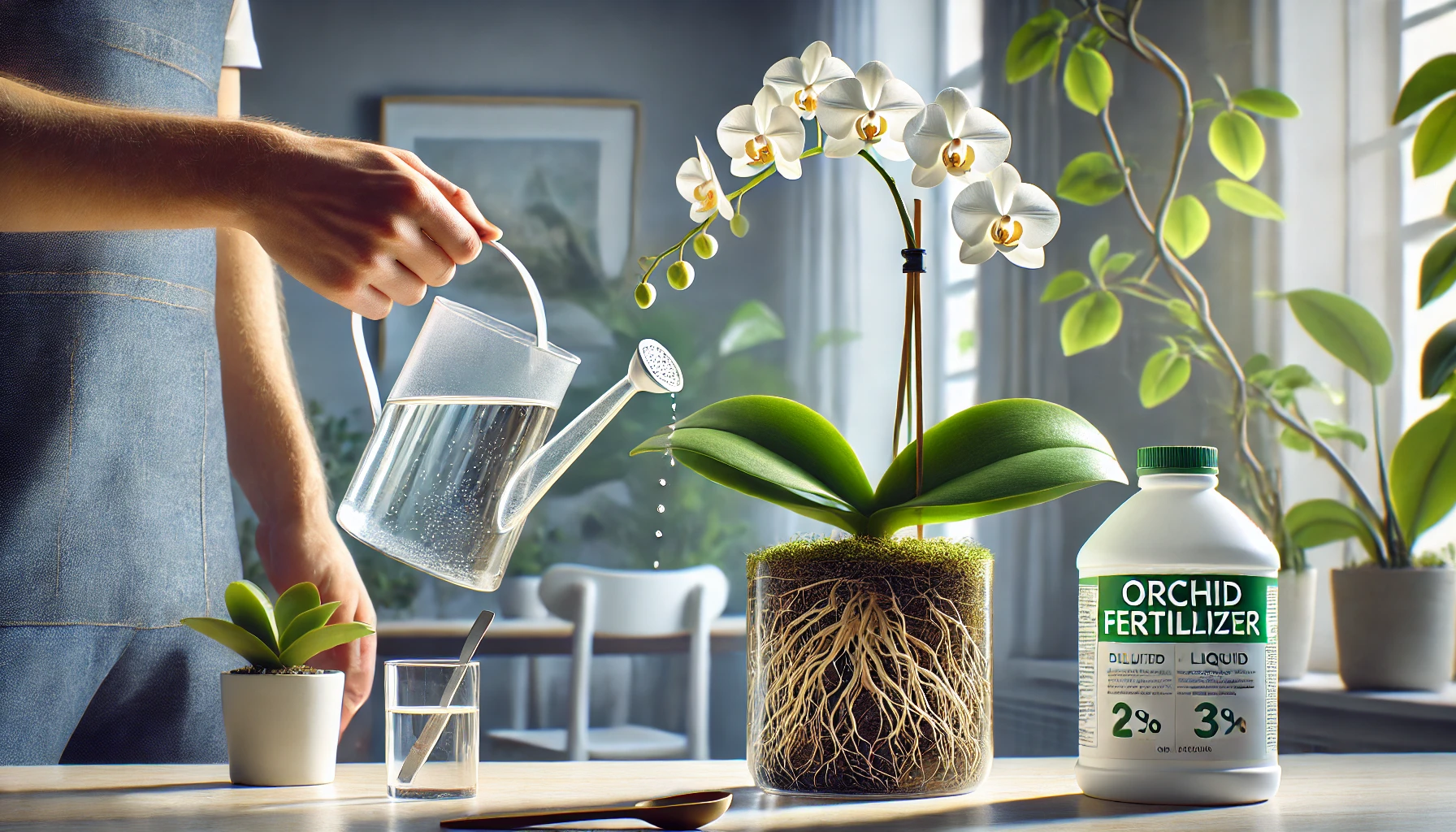Fertilizing orchids is essential for their health, strong root development, and beautiful blooms. However, choosing the right fertilizer can be confusing, especially with so many options available. Understanding which nutrients orchids need, how often to fertilize, and which type of fertilizer works best will help keep your orchids thriving.
🌱 Why Do Orchids Need Fertilizer?
Unlike typical houseplants that grow in soil, most orchids are epiphytes, meaning they attach to trees and absorb nutrients from rain, decaying leaves, and the air. Since potted orchids don’t have access to natural nutrients, they rely on fertilizers to stay healthy.
✔ Benefits of Fertilizing Orchids:
- Encourages strong root growth, helping orchids absorb water and nutrients.
- Promotes healthy leaves, which support photosynthesis and overall plant strength.
- Stimulates flower production, ensuring beautiful, long-lasting blooms.
- Prevents nutrient deficiencies that can cause weak stems, yellow leaves, and slow growth.
💡 A well-fed orchid is more likely to bloom consistently and stay resistant to stress.
🌿 Key Nutrients in Orchid Fertilizers
Orchids require three main macronutrients:
✔ Nitrogen (N): Encourages leaf and stem growth. Essential for young or recovering orchids.
✔ Phosphorus (P): Strengthens roots and helps trigger blooming.
✔ Potassium (K): Improves plant health, disease resistance, and flower longevity.
Most orchid fertilizers have a ratio of these nutrients, such as 20-20-20 (balanced) or 10-30-20 (bloom booster).
💡 A balanced fertilizer is best for general orchid care, while a bloom booster is useful when encouraging flowers.
💧 Liquid, Granular, or Organic? Choosing the Best Type of Fertilizer
There are different types of orchid fertilizers, each with its own benefits.
✔ Liquid Orchid Fertilizer
- Fast-acting and easy to dilute.
- Ideal for weekly feeding.
- Works well when applied as a light spray on leaves and roots.
✔ Granular or Slow-Release Fertilizer
- Releases nutrients gradually over several months.
- Requires less frequent applications.
- Best for growers who prefer a low-maintenance approach.
✔ Organic Orchid Fertilizers
- Made from natural sources like banana peels, eggshells, or composted materials.
- Gentler on orchids but may require more frequent application.
💡 Liquid fertilizers are the most effective for regular orchid feeding because they provide immediate nutrients.
📅 How Often Should You Fertilize Orchids?
Orchids have different nutrient needs depending on their growth stage and season.
✔ Best Fertilizer Schedule for Orchids:
- During active growth (spring & summer): Fertilize once a week using a diluted liquid fertilizer.
- When flower spikes appear: Switch to a bloom booster fertilizer (10-30-20) every two weeks.
- During dormancy (fall & winter): Fertilize once a month or stop completely if the orchid is not actively growing.
💡 Orchids follow the “weekly, weakly” rule—feed lightly and often rather than using too much fertilizer at once.
🛑 Common Mistakes When Fertilizing Orchids
❌ Overfertilizing – Too much fertilizer can cause root burn, leaf discoloration, and weak flowers. Always dilute to half strength before applying.
❌ Fertilizing dry roots – Always water orchids first before fertilizing to prevent root damage.
❌ Using high-nitrogen fertilizer year-round – Encourages leaf growth but prevents flowering. Switch to a bloom booster when necessary.
❌ Applying fertilizer to the crown – Excess fertilizer in the crown (center of the plant) can cause rot. Only apply to the roots and leaves.
💡 It’s better to under-fertilize than to over-fertilize—orchids can recover from too little food, but overfeeding can damage them permanently.
🏡 Best Homemade Fertilizers for Orchids
If you prefer a natural approach, you can make effective fertilizers using simple household ingredients.
✔ Banana Peel Fertilizer (High in Potassium & Phosphorus)
- Chop up a banana peel and soak it in 1 liter of water overnight.
- Strain and use the water to fertilize your orchids every two weeks.
✔ Eggshell Fertilizer (Rich in Calcium & Magnesium)
- Crush 5 eggshells and boil them in 1 liter of water for 10 minutes.
- Let cool, strain, and use the water to mist or water orchids once a month.
✔ Rice Water (Mild All-Purpose Fertilizer)
- Save the water used to rinse rice and use it to water orchids every two weeks.
- Contains natural starches and minerals that help with root growth.
💡 Homemade fertilizers should always be diluted to avoid overfeeding orchids.
🌞 Fertilizing Orchids for Better Blooms
Many orchid owners struggle with plants that grow well but never flower. Proper fertilization plays a key role in encouraging blooms.
✔ How to Fertilize for Flowering:
- Use a bloom booster fertilizer (10-30-20) when a flower spike begins to grow.
- Reduce nitrogen-heavy fertilizers, which focus on leaf growth rather than flowers.
- Keep orchids in bright, indirect light, as light exposure also affects blooming.
- Ensure cooler nighttime temperatures (55–65°F / 13–18°C), as this helps trigger flowering.
💡 Switching to a bloom-focused fertilizer at the right time will encourage beautiful, long-lasting flowers.
🚫 Signs Your Orchid is Getting Too Much or Too Little Fertilizer
✔ Too Much Fertilizer:
- Burned root tips (black or brown ends).
- Salt buildup on the potting mix.
- Soft, weak leaves that feel thin or limp.
✔ Too Little Fertilizer:
- Slow growth or no new leaves or roots.
- Leaves turning pale green or yellow due to lack of nutrients.
- No flower spikes for over a year.
💡 If overfertilized, flush the potting mix with clean water to remove excess salts. If under-fertilized, start a weak feeding schedule.
🛡 Final Tips for Choosing and Using Orchid Fertilizer
✔ Use a balanced fertilizer (20-20-20) for general growth and a bloom booster (10-30-20) for flowering.
✔ Fertilize once a week in growing season and reduce feeding in winter.
✔ Always dilute fertilizer to avoid root damage.
✔ Water orchids before fertilizing to prevent burning.
✔ Adjust feeding if your orchid shows slow growth, weak roots, or lack of blooms.
By choosing the right fertilizer and applying it correctly, you’ll ensure your orchids stay strong, healthy, and full of beautiful blooms! 🌸✨
